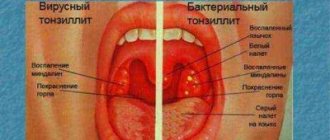Chronic tonsillitis is nothing more than a consequence of untreated sore throat. Frequent inflammation in the palatine tonsils ultimately leads to their enlargement.
At the same time, bacteria nest in the deep layers of the tonsils - the follicles, which weaken the protective function of the lymphoid tissue.
As a result of the slightest cold or drinking cold drinks, microorganisms are activated, which causes exacerbations of chronic tonsillitis that require treatment. Inflammation poses a danger to other organs - let’s find out why chronic tonsillitis is dangerous.
What are tonsils for?
The immune system is represented by blood cells or lymphoid tissue located in the nasopharynx in the form of 7 tonsils. They make up the pharyngeal ring:
- unpaired - laryngeal, pharyngeal and lingual;
- paired - palatine and tubal tonsils.
Pathogenic pathogens entering the respiratory tract certainly pass through the tonsils, where they settle. At the same time, the body’s protective reaction is triggered. Lymphoid cells of the tonsils (T-lymphocytes and antibodies in the form of immunoglobulins A) rush to attack, destroying or weakening viruses and bacteria.
This happens if the tonsils are not damaged. With hypertrophy, microorganisms nest in the tonsils and multiply. In this case, inflammation develops. The outcome of the fight depends, on the one hand, on the level of local immunity, and on the other, on the aggressiveness of bacteria and their resistance to antibiotics.
Prevention of exacerbations of chronic tonsillitis
- Carry out wet cleaning in the house, removing dust and other particles settling on surfaces.
- Clean the filters in your air conditioner regularly.
- Strengthen the immune system with rational, regular nutrition, hardening, and exercise.
- It is reasonable to divide time for work, sleep and rest, without tiring the body with your lifestyle.
- Give up bad habits, not only traditional smoking, but also e-cigarettes and hookahs.
- Promptly treat dental diseases, as well as inflammation in the nasopharynx and oropharynx.
- If possible, change the harmful activity to work in a more favorable atmosphere.
- Visit an otolaryngologist regularly for preventive procedures and examinations.
Why is chronic tonsillitis dangerous?
With frequently recurring inflammation of the tonsils, lymphoid cells are replaced by connective tissue, and scars form. The narrowing of the opening of the lacunae creates conditions for the proliferation of bacteria and the accumulation of food debris. As a result, the infection spreads through the bloodstream.
The consequence of chronic tonsillitis is intoxication of the body. It is manifested by low-grade fever, decreased performance, and headache. The sensitivity of tissues to toxins increases, allergic reactions occur.
Important! The danger of tonsillitis is that it is a source of constant infection that can spread through the bloodstream, reaching the heart.
Complications of chronic tonsillitis:
- rheumatic carditis - inflammation of the heart muscle;
- rheumatic chorea;
- rheumatic arthritis - inflammation of the joint membranes.
The cause of complications after chronic tonsillitis is the effect on the heart of toxins - waste products of bacteria. The failure of the immune system plays an important role in the mechanism of complications.
The pathological reaction is manifested by the fact that protective cells attack the body’s own tissues, which they perceive as foreign.
In chronic tonsillitis, complications also affect neighboring tissues. The infection spreads through the lymphogenous route. Paratonsillitis and pharyngeal abscess may develop.
How to cure chronic tonsillitis
Chronic tonsillitis is a disease in which a chronic inflammatory process occurs in the tissue of the palatine tonsils. With this disease, a bacterial infection is constantly present in the thickness of the lymphoid tissue of the tonsils, which causes their increase in size and disruption of their function. The disease is characterized by periodic exacerbations (especially in the autumn-winter period), accompanied by certain symptoms, and an exacerbation of chronic tonsillitis is nothing more than a sore throat. The disease most often manifests in childhood, but chronic tonsillitis is often diagnosed in adults.
The cause of the development of chronic tonsillitis is most often untreated tonsillitis (acute tonsillitis). Sometimes the occurrence of constant inflammation in the tonsils is facilitated by the presence of a chronic source of infection in the oral cavity (dental caries) or in the upper respiratory tract (sinusitis, pharyngitis).
Course of tonsillitis
During exacerbation, the disease proceeds like a regular sore throat. There is a pain in the throat when swallowing. When examining the pharynx, severe hyperemia of the palatine tonsils is noted. The temperature rises, symptoms of intoxication appear:
- chills;
- muscle aches;
- nausea;
- headache.
As for chronic tonsillitis, it occurs in various clinical forms - simple protracted, recurrent or toxic allergic.
Attention! The progression of the disease is accompanied by dysfunction of the heart, severe inflammation of the joints, and changes in the kidneys.
With any form there are common signs:
- periodic or constant hyperthermia;
- lymphadenitis of the mandibular nodes;
- joint pain;
- frequent occurrence of sore throat more than four to five times throughout the year;
- fast fatiguability;
- weakness.
With exacerbation of chronic tonsillitis, treatment and symptoms vary. This is due to the characteristics of the patient and the form of the disease. Therefore, at the first manifestations of inflammation, it is necessary to consult a doctor for correction or prescribing appropriate medications.
Clinical picture of the disease
Chronic tonsillitis is characterized by its occurrence in two forms:
- [compensated];
- [decompensated].
Any of these forms occurs with periods of exacerbations and remissions.
Important to know: Treatment of tonsillitis at home
The compensated form of chronic tonsillitis is distinguished by the fact that the patient has only local symptoms.
This form is not characterized by general symptoms of the disease. At this time, the tonsils are still doing their protective work.
The patient has the following symptoms:
- discomfort in the throat;
- dry mucous membranes lead to soreness;
- due to the waste products of microbes, a putrid odor appears from the mouth;
- plugs on the tonsils are visible;
- a little pus can be found in the lacunae;
- with frequent exacerbations there are adhesions and scars.
The compensated form is characterized by exacerbations no more than three times during the year.
The decompensated form of chronic tonsillitis is distinguished by the general symptoms of the disease. Local signs are accompanied by symptoms of general infectious intoxication of the body:
- headache;
- temperature rise to subfebrile level;
- a person gets tired quickly;
- general malaise.
There may also be signs of the development of complications, which more often develop in the decompensated stage of the process.
With exacerbation, signs of an acute process (angina) appear. Since the process of bacterial etiology occurs, lacunar or follicular forms of tonsillitis arise.
In this case, characteristic symptoms of exacerbation of the disease appear:
- [sharp increase in body temperature] to high numbers (39 - 40 degrees);
- sore throat increases significantly;
- It is very painful to swallow, so you may refuse to eat or drink;
- severe intoxication of the body;
- aches throughout the body;
- severe malaise;
- purulent follicles on the tonsils;
- accumulation of purulent discharge in the lacunae of the tonsils.
Also another form of exacerbation is peritonsillar abscess.
In this case, accumulations of pus are found in the peritonsillar tissue. The beginning of the process is similar to the development of angina, the patient develops the same complaints.
But a little later, the patient develops difficulty swallowing, he can no longer swallow anything.
Important to know: How to gargle for chronic tonsillitis
This is explained by the development of pronounced tissue edema. Later, the patient can no longer open his mouth due to pain. The patient requires emergency treatment in a hospital setting.
Causes
Important! Chronic tonsillitis usually forms after acute inflammation of the tonsils - sore throat. And only in 3% of cases does it develop initially without it.
The disease most often affects school-age children. In adults under 40 years of age, it occurs in 10% of cases. The development of chronic tonsillitis is facilitated by nasal pathologies and diseases of viral or bacterial origin:
- the main reason is decreased immunity;
- infections of the digestive system that reduce the body's defenses;
- structural pathology of the nasal cavity that impairs breathing through the nose - deviated septum, dilated conchae, adenoid growths;
- sinusitis, adenoiditis, dental caries - foci of chronic infection, provoking exacerbation of tonsillitis - relapse of sore throat;
- recurrent acute respiratory viral infections;
- measles or scarlet fever, which reduce immunity;
- current tuberculosis process;
- malnutrition with deficiency of vitamins and minerals.
Most often, exacerbation of tonsillitis is associated with the internal causes listed above, and not infection from other persons.
The causative agents of infection nesting in the nasopharynx, according to the frequency of distribution, are β-hemolytic staphylococcus A, Staphylococcus aureus, herpes virus, chlamydia, and toxoplasma.
The diagnosis of chronic tonsillitis is based on frequent repeated exacerbations in the patient's history, disruption of the structure of the tonsils, and allergic manifestations of infection.
Treatment in children
To treat chronic tonsillitis at the acute stage in young patients, it is possible with the help of drugs, physiotherapy, and surgery. In addition, it is important to follow the doctor’s instructions regarding proper nutrition and walks in the fresh air.
In general, treatment in children comes down to the following:
- Taking antibiotics. The doctor prescribes this or that drug, taking into account what symptoms the patient has and what his microflora is. Antibacterial drugs can be prescribed for both mild and severe effects. At the same time, in combination with antibiotics, it is important to take probiotics so as not to harm the functioning of the gastrointestinal tract.
- Antiseptic drugs . They are sold in the form of aerosols, sprays and solutions.
- Desensitizing treatment . Its purpose is to relieve swelling of the tonsils. In addition, they have an effect on the mucous membrane of the posterior wall of the human pharynx. Using similar medications can improve the absorption of other drugs.
- As you know, chronic tonsillitis reduces immunity . Therefore, the doctor will definitely include immunostimulating medications in the treatment regimen. Thanks to them, it is possible to activate the body’s defenses and defeat the disease.
- Homeopathic medicines. Thanks to them, the nutritional function of the affected tonsil improves. For these purposes, both drugs and rinsing solutions can be used. Ultrasonic and steam inhalations, which are based on medicinal herbs, are also effective.
- Softening therapy . It is used when there is severe soreness or dryness in the throat. For these purposes, you can use peach oil. It drips into the nose. 3% perhydrol remains effective. Use it when gargling. You need to take 200 ml of water and add 10 drops of hydrogen peroxide. Rinse 1-2 times a day.
- Painkillers. They should only be used when the patient is experiencing severe pain.
- Proper nutrition. In order for the treatment of chronic tonsillitis at the acute stage to be successful, the child must monitor his diet. Thus, his diet should not include fried, smoked, salty and sour foods. During an exacerbation, also do not eat hard or tough foods.
On video of an exacerbation of chronic tonsillitis in a child:
Chronic tonsillitis in the acute stage, and acute tonsillitis (ICD code 10 - J03) are very dangerous diseases, since without appropriate treatment they can cause multiple complications. Therapy should take an integrated approach so that you can get rid of not only the symptoms, but also the cause of the disease. Read how acute tonsillitis in a child is treated.
Antibiotics for chronic tonsillitis
For mild exacerbations, doctors limit themselves to the use of topical antibacterial drugs in the form of sprays. But their selection is also made after the results of bacteriological culture.
The most popular local antibiotic is Bioparox. It is produced in the Servier laboratory, which is part of the French company. The active substance fusafungin actively fights bacteria, reducing the inflammatory process.
Exacerbation of chronic tonsillitis should be treated like a sore throat with antibacterial agents.
By the way! The doctor selects an antibiotic based on the results of bacterial culture of material from the tonsils. The most pronounced sensitivity of hemolytic streptococcus to the antibiotic is taken into account.
Most often, the choice falls on the penicillin group. Among them, today Sumamed is considered more effective and convenient to use.
The product is available in different dosage forms and dosages, and is also suitable for treating children. The drug is used once a day.
In addition to Sumamed, the doctor may prescribe Flemoxin Solutab, Augmentin, Hemomycin. With a long course of treatment, probiotics are additionally used to regulate intestinal microflora.
Attention! Antibiotics are not used during remission.
Treatment in adults
When treating exacerbation of chronic tonsillitis in adults, conservative and surgical methods can be used. Conservative treatment
During an exacerbation of the chronic form of tonsillitis, a sore throat occurs. It develops against the background of the proliferation of pathogenic microflora in the tonsils. For this reason, the main treatment in adults remains the use of medications such as antibiotics and antiseptics.
What a paratonsillar abscess is and what it looks like can be seen in the photo in this article.
But what are the signs of a peritonsillar abscess, and how this disease is treated, is described in great detail in this article.
This article will help you understand how treatment occurs after opening a paratonsillar abscess: https://lechim-gorlo.ru/g/bolezni-g/abscess/paratonzillyarnyj-vskrytie.html
How vacuum cleaning of the tonsils occurs during tonsillitis is described in great detail in this video.
Antibacterial therapy should begin immediately after the following symptoms are detected: redness of the throat and rise in temperature. Antibiotics can be taken in the form of tablets or injections. When tonsillitis worsens, the patient is prescribed antibacterial drugs of the penicillin and cephalosporin group.
Among the most effective:
- Ampicillin,
- Amoxicillin (can you take Amoxicillin for a cold? This article will help you understand)
Amoxicillin in the photo - Cefazolin,
On photo-cefazolin - Ceftriaxone (this article describes how sinusitis is treated with Ceftriaxone antibiotics)
If after 2 days from the start of taking these drugs there is no positive dynamics, then the doctor decides to replace the chosen drug with another. This often happens in people who have repeatedly taken antibiotics and the bacteria have become addicted. To accurately determine the resistance of microorganisms to antibiotics, you need to undergo a bacteriological examination to determine the sensitivity of the bacteria to antibacterial drugs.
In addition to antibiotics, it is necessary to treat chronic tonsillitis in the acute stage with the help of antiseptic solutions. They are used to rinse the mouth and throat. Carry out therapeutic measures 5-10 times a day. It is advisable to use Furacillin, Iodinol. For local therapy, throat sprays are used - Ingalipt (what is the price of Ingalipt spray) and Hexoral (how much does Hexoral spray cost, you can find out from this article)
In the photo - furatsilin
You can reduce painful symptoms in the throat and get an antiseptic effect with the help of special lozenges. They need to be absorbed throughout the day. Among the most effective are Faringosept (which is better to use during pregnancy, Lizobact or Faringosept, this article will help you understand)
Surgery
Often, the attending physician, when treating tonsillitis in the acute stage, decides to perform a tonsillectomy. This is an operation to remove tonsils. But it should be carried out only for certain indications. Thus, it is advisable to perform surgical intervention for recurrent peritonsillar abscesses. Therefore, when tonsillitis occurs without complications, it is better to use conservative therapy methods.
Video of removal of chronic tonsillitis:
Surgery is not recommended for the following pathologies:
- Leukemia;
- Active tuberculosis;
- Nephritis;
- Heart disease.
Folk remedies
When treating tonsillitis at home in adults, you can use the following folk remedies:
- Propolis .
Finely chop the raw material and combine with alcohol in equal quantities. Store in a dark place for 5 days. Then take a daily dose of 20 drops 3 times a day. Take the medicine for 21 days. In the photo - propolis for treatment - Garlic drops .
It is necessary to chop the garlic and combine it with vegetable oil in equal quantities. Keep the mixture for 5 days in a dark room. Then filter and add a couple of drops of lemon juice. Take the resulting product 10 drops 2 times a day. In the photo - drops of garlic - Beet .
Remove the peel from the vegetable and chop it finely. Mix with 800 ml of water, place on the stove and cook for 1 hour. Filter the prepared broth and use it to gargle. In the photo - beets for the treatment of tonsillitis
Causes and signs of the disease
Chronic tonsillitis is a long-term inflammation of the tonsils
The palatine tonsils consist of lymphoid tissue that has lacunae, that is, small depressions. When inhaled, various bacteria and viruses settle on this tissue and do not enter the respiratory tract. In other words, the main function of the tonsils is protective.
It is for this reason that very often acute tonsillitis becomes chronic. Constantly encountering pathogenic microorganisms, the lymphoid tissue becomes inflamed, and streptococci and staphylococci accumulate in the gaps, which are activated when immunity declines.
The most common cause of the chronic form of the disease is improper or incomplete treatment of acute tonsillitis. Other reasons include:
- Purulent process. The presence of caries and sinusitis leads to the fact that bacteria spread to other tissues, reaching the tonsils, causing purulent tonsillitis.
- Hypothermia. Inhalation of cold air provokes the development of the inflammatory process. It may begin with a simple sore throat, but over time progresses to tonsillitis.
- Impaired nasal breathing. Tonsillitis can be caused by a deviated nasal septum, prolonged rhinitis (including allergic), sinusitis, and nasal polyps. Impaired breathing leads to the fact that a person cannot breathe normally through the nose and begins to breathe through the mouth. Thus, the likelihood of bacteria getting into the tonsils increases significantly.
- Poor nutrition. This leads to a decrease in general and local immunity. Also, the immune system is negatively affected by improper drinking regimen and insufficient consumption of clean water.
Chronic tonsillitis has various forms, but, as a rule, its symptoms are recognizable. The patient develops a severe sore throat, which intensifies when swallowing and speaking, and the temperature rises. The tonsils increase in size, turn red, and pustules are clearly visible on them. Dry mouth, headache, and fatigue may also occur.
Types, symptoms of chronic tonsillitis and complications of the disease
When making a diagnosis, local and systemic symptoms are assessed, anamnesis is collected, the patient’s complaints and the general clinical picture of tonsillar syndrome are analyzed. Local tonsillitis symptoms that are important in diagnosis are manifestations of any inflammatory processes in the tissues of the palatine tonsils. In the chronic form, symptoms characteristic of the whole organism (systemic) are explained by the influence of cytokines and tissue breakdown products spreading from the infectious focus through the bloodstream. You should also take into account the influence of toxic substances released due to pronounced microbial invasion into the lymphoid tissue of the palatine tonsils. Depending on the nature, frequency of exacerbations and the general reaction of the body, several types of chronic tonsillitis are distinguished:
- Simple recurrent chronic tonsillitis, with frequent acute tonsillitis.
- Simple protracted tonsillitis, with signs of a constant sluggish inflammatory process.
- Simple compensated, with long periods of remission and rare relapses.
- Toxic-allergic tonsillitis.
The toxic-allergic form of the disease includes two types. With the first type, a number of symptoms are observed that indicate an increase in the level of allergization and intoxication of the body. These are hyperthermia, pain in the heart, increased fatigue, joint pain. The symptoms are not accompanied by functional disorders of organs and systems. At the second stage, signs of intoxication are confirmed during examinations: disturbances in cardiac activity are detected, test results confirm inflammatory processes in the joints, organs of the genitourinary system, kidneys, and liver.
Common symptoms of chronic tonsillitis include:
- frequent exacerbations of tonsillitis in the form of sore throats (in the simple form - 3-5 times a year) due to hypothermia, overwork, fasting, viral or bacterial infection; dryness of the pharyngeal mucosa, pain, foreign body sensations during swallowing;
- periodic (in the toxic-allergic form of the second type - constant) increase in temperature to subfebrile levels; presence of bad breath;
- enlargement and tenderness of the mandibular lymph nodes;
- general fatigue, headaches, decreased body resistance;
- When examining the pharynx, hyperemia, thickening, swelling of the palatine arches, tonsils are revealed, the presence of translucent mucous plaque and lacunar plugs is possible.
Exacerbation of chronic tonsillitis is also sometimes called purulent tonsillitis. Exacerbation occurs in the form of bacterial or viral tonsillitis. Depending on the type of pathogen, it can be herpetic tonsillitis, streptococcal or adenoviral tonsillitis. The disease is accompanied by local manifestations (sore throat, severe swelling, redness of the tonsils and palatine arches, the presence of purulent foci), a sharp increase in temperature, signs of general intoxication of the body (fever, headaches, aches in the muscles, joints, nausea, weakness, etc. .).
With exacerbation of chronic tonsillitis, symptoms and treatment may vary due to the individual characteristics of the patient and the etiology of the disease, which requires consultation with a doctor to differentiate the diagnosis and prescribe a course of therapy.
Chronic tonsillitis is more typical for children, although it is often observed in adults, characterized by the predominance of local symptoms over general signs of the disease. Chronic tonsillar symptom in adulthood is most often a consequence of self-treatment of an acute disease, tonsillitis, or adenoviral infection. The cause may also be the presence of an infectious focus in the oral cavity: gingivitis, caries, etc.
In older people, there is a natural process of reducing the volume of lymphoid tissues and a decrease in the concentration of immunocompetent cells, and therefore acute and chronic tonsillitis occur with erased symptoms; the clinical picture rarely shows febrile body temperature and severe pain, giving way to prolonged hyperthermia in the subfebrile range and signs of general intoxication of the body.
The disease is dangerous due to the presence of a permanent source of infection in the body, which contributes to the development of severe disturbances in the functioning of organs and systems. The most common consequences of the rheumatic type are:
- rheumatic carditis;
- rheumopolyarthritis (with damage to the synovial membrane of the joint);
- rheumochorea, which affects the nervous system of the body;
- inflammatory lesions of the skin of a rheumatic nature.
Rheumatism develops under the influence of two factors: the influence of toxins secreted by pathogenic microorganisms on the heart tissue and the similarity of the antigens of some strains of streptococcus with those inherent in the human body. The second factor causes a pathological systemic autoimmune response, in which immune cells begin to attack a person’s own cells, perceiving them as foreign. In addition to the general effect on health, the inflammatory process can also develop locally, causing paratonsillitis, the formation of retropharyngeal and parapharyngeal abscesses.
Treatment methods for chronic tonsillitis
Medication
- The use of antibiotics during exacerbation of tonsillitis is a mandatory method of combating the disease. Depending on the type of bacteria identified, Amoxicillin, Erythromycin, Cefazolin, etc. are prescribed. The treatment principle is the same for adults and children. Differences in dosage and form of the drug.
- Rinsing the oropharynx is a necessary measure to eliminate the accumulation of pathogenic microbes on the affected tonsils at the time of exacerbation of the disease. Miramistin, Stop-Angin, Ingalipt, Hexoral are used. Medicines have an antibacterial effect, reduce pain in the throat, and help accelerate the regeneration of mucous membranes.
- Nasal drops - often the infection affects not only the oral cavity, but also the respiratory tract. To eliminate pathogenic bacteria during exacerbation of the disease, it is recommended to use drops of Isofra, Pinosol, Polydex. Vasodilator sprays can be used to make breathing easier.
Physiotherapeutic
- Warming up with dry heat - using ultraviolet or laser. The method helps reduce the concentration of pathogenic microbes during an exacerbation of the disease.
- Inhalations are an additional procedure that helps soothe an irritated throat. If you add the drugs Miramistin, Chlorophyllipt or Furacilin to the liquid for inhalation, the antibacterial effect will also be noticeable from the procedure.
- Ultrasound waves are a painful procedure, therefore they are not prescribed for the treatment of tonsillitis in children during an exacerbation. The method affects the purulent formations of the tonsils, promoting their accelerated opening and outflow of exudate.
Surgical
- Tonsil removal – During the process, the tonsils are either completely removed or partially removed. The latter is quite rare. They resort to similar treatment for constant exacerbations of tonsillitis.
- Freezing the tonsils is the effect of low temperatures on the inflamed parts of the tonsils in order to destroy pathogenic microbes. It is a modern method of getting rid of chronic tonsillitis and its constant exacerbations.










